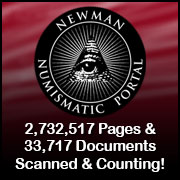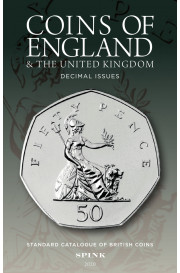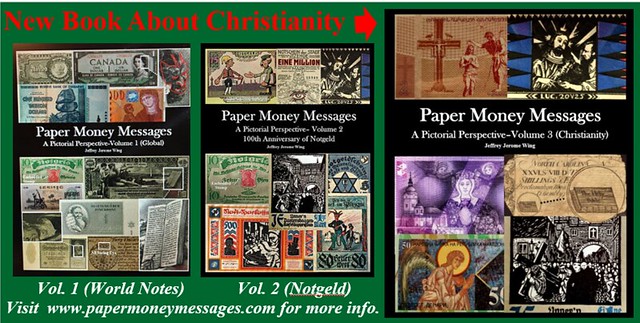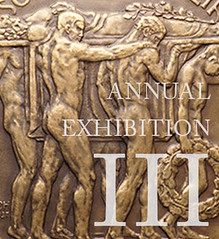
About UsThe Numismatic Bibliomania Society is a non-profit association devoted to the study and enjoyment of numismatic literature. For more information please see our web site at coinbooks.org SubscriptionsThose wishing to become new E-Sylum subscribers (or wishing to Unsubscribe) can go to the following web page link MembershipThere is a membership application available on the web site Membership Application To join, print the application and return it with your check to the address printed on the application. Print/Digital membership is $40 to addresses in the U.S., and $60 elsewhere. A digital-only membership is available for $25. For those without web access, write to: Charles Heck, Treasurer
AsylumFor Asylum mailing address changes and other membership questions, contact Chuck at this email address: treasurer@coinbooks.org SubmissionsTo submit items for publication in The E-Sylum, write to the Editor at this address: whomren@gmail.com BUY THE BOOK BEFORE THE COINSale Calendar
|
- WAYNE'S WORDS: THE E-SYLUM DECEMBER 8, 2019
- NEW BOOK: THIAN'S MASTERPIECE: A LEAF BOOK
- NEW BOOKS: COINS OF ENGLAND 2020
- NEW BOOK: COIN YEARBOOK 2020
- BOOK REVIEW: EARLY DATED COINS OF EUROPE, 2ND ED.
- E-GOBRECHT EDITOR BILL BUGERT STEPS DOWN
- GARY LEE PATTERSON (1939-2017)
- CHRISTMAS COINS ON THE NEWMAN PORTAL
- MORE ON THE COIN PETTING ZOO
- NOTES FROM E-SYLUM READERS: DECEMBER 8, 2019
- MORE ON THE MINT'S MANUFACTURED RARITIES
- WHITMAN COIN COLLECTOR CARDS POSTER SURFACES
- VOCABULARY TERM: ORIENTATION
- WINSOR, RICHARD BROWN (1848-1889)
- HARVEY STACK'S NUMISMATIC FAMILY, PART 58
- ARTICLE PROFILES MEDAL DESIGNER CHESTER MARTIN
- MEDIALIA GALLERY EXHIBITS THRU FEBRUARY 2020
- SS CENTRAL AMERICA 1856-S/S QUARTERS DISCOVERED
- EAGLES OF THE TYRANT COLLECTION EXHIBIT
- SOVEREIGN RARITIES NYINC 2020 AUCTION HIGHLIGHTS
- CHRISTIAN GOBRECHT'S 1826 ARCHIMEDES MEDAL
- 1826 GOLD ERIE CANAL COMPLETION MEDAL
- CONFEDERATE $20 NOTE HELD BY LEE AT APPOMATTOX
- LOOSE CHANGE: DECEMBER 8, 2019
- FEATURED WEB SITE: NEW YORK TOLL SCRIP & TOKENS
Click here to access the complete archive a
Click here to unsubscribe (scroll down)
To comment or submit articles, reply to whomren@gmail.com
Content presented in The E-Sylum is not necessarily researched or independently fact-checked, and views expressed do not necessarily represent those of the Numismatic Bibliomania Society.
WAYNE'S WORDS: THE E-SYLUM DECEMBER 8, 2019
 We have no new subscribers this week; our total count is 6,061 subscribers.
We have no new subscribers this week; our total count is 6,061 subscribers.
Thank you for reading The E-Sylum. If you enjoy it, please send me the email addresses of friends you think may enjoy it as well and I'll send them a subscription (but let me know if they are located in the European Union). Contact me at whomren@gmail.com anytime regarding your subscription, or questions, comments or suggestions about our content.
NBS Members: It's that time of year again - please renew your membership by check or online with Paypal. For more information, see:
https://www.coinbooks.org/about/
membership.html
This week we open with four new books, one review, an E-Gobrecht editor change, the loss of a prominent exonumia researcher, Christmas coins and the coin petting zoo.
Other topics this week include manufactured rarities, Whitman coin collector cards, coin and medal orientation, collector Richard Brown Winsor, coin and medal designer Chester Martin, Medialia Gallery's new exhibits, new discoveries from the SS Central America, the Eaglres of the Tryant Collection, and Gobrecht's Archimedes medal.
To learn more about the collecting and study of Confederate paper money, the coins of England, swastika tokens, the Whitehead & Hoag Co., engraver Anton Teutenberg, billon beshlyks, the Colin Powell Congressional Gold medal, 1856 S/s quarters, Robert E. Lee's $20 Confederate note, and New York toll scrip, read on. Have a great week, everyone!
Wayne Homren
Editor, The E-Sylum
NEW BOOK: THIAN'S MASTERPIECE: A LEAF BOOK
Books about books are a bibliophile's delight. David Fanning has written a new book about the collecting and study of Confederate paper money in the 19th century and Raphael P. Thian's The Currency of the Confederate States of America. -Editor
Thian's Masterpiece: A Leaf Book
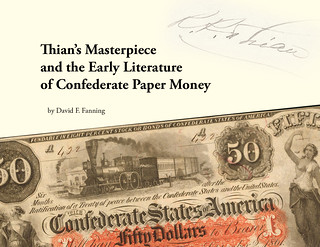 Kolbe & Fanning Numismatic Booksellers have announced the publication of
Thian's Masterpiece and the Early Literature of Confederate Paper Money, by David F. Fanning. This publication traces the development of the study of the Treasury Notes
issued by the Confederate States of America and outlines the literary history of the subject. Beginning with Thomas Addis Emmet's 1867 articles in the American Journal of
Numismatics, Fanning discusses the various publications devoted to the collecting and study of Confederate paper money in the 19th century, culminating with the publication in
the early 20th century of Raphael P. Thian's The Currency of the Confederate States of America.
Kolbe & Fanning Numismatic Booksellers have announced the publication of
Thian's Masterpiece and the Early Literature of Confederate Paper Money, by David F. Fanning. This publication traces the development of the study of the Treasury Notes
issued by the Confederate States of America and outlines the literary history of the subject. Beginning with Thomas Addis Emmet's 1867 articles in the American Journal of
Numismatics, Fanning discusses the various publications devoted to the collecting and study of Confederate paper money in the 19th century, culminating with the publication in
the early 20th century of Raphael P. Thian's The Currency of the Confederate States of America.
In addition to the regular edition of Fanning's study, a deluxe portfolio edition has been prepared. The Currency of the Confederate States of America is a very rare publication that combines Thian's most thorough treatment of the subject with an album of around 300 actual specimens of Confederate currency. Very few copies remain intact today, with many having been broken up over the years and the notes sold individually. When an incomplete copy became available, the idea was formed to make this publication better known to the collectors of today by creating a leaf book.
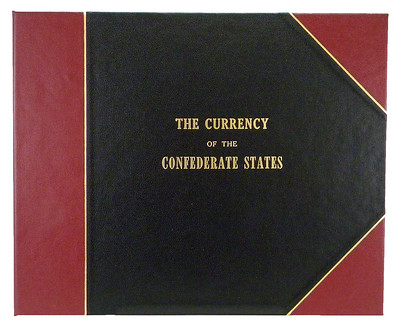
Twenty-four copies of Fanning's study have been bound in a custom-made portfolio, each of which also includes one original leaf from an incomplete copy of Thian's The Currency of the Confederate States of America. Some of these leaves include the original specimens of Confederate paper money that Thian mounted to them, while other leaves are text only.
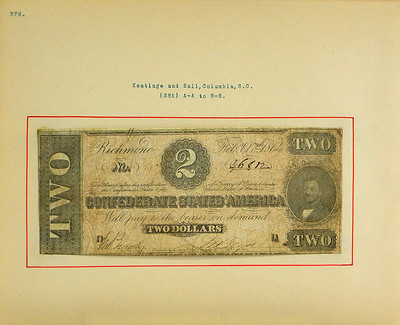
Fanning's study can be purchased on its own for $25 plus $5 domestic postage. Only 100 copies have been printed, each numbered and signed by the author, with 24 of them reserved for inclusion in the portfolios.
For more information, or to order, see:
THIAN'S MASTERPIECE AND THE EARLY LITERATURE OF CONFEDERATE PAPER MONEY.
(https://www.numislit.com/new-arrivals.php?category_id=291&action=recarr)
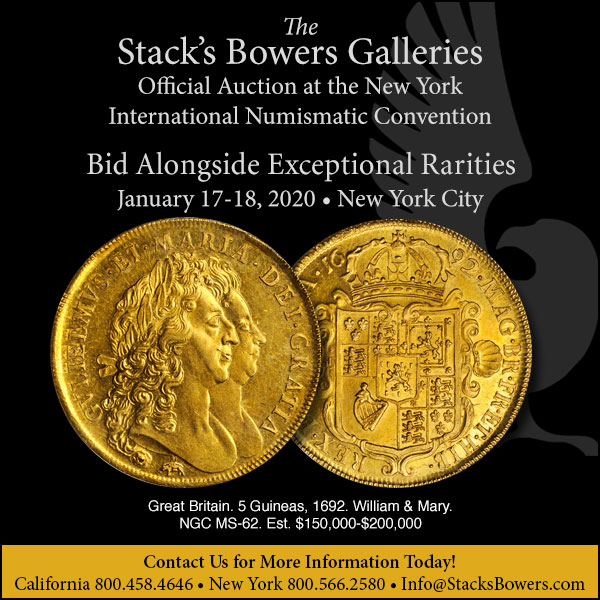
NEW BOOKS: COINS OF ENGLAND 2020
SPINK has published the 2020 editions of the Coins of England & the United Kingdom books, offering the pre-decimal and decimal volumes separately. -Editor
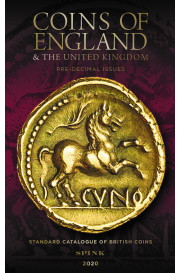 Coins of England & the
United Kingdom 55th Edition 2020 (Pre-Decimal Issues)
Coins of England & the
United Kingdom 55th Edition 2020 (Pre-Decimal Issues)
by Howard, E (ed.)
Hardback
216 x 138mm
576pp with colour illustrations throughout
RRP £30
ISBN: 978-1-912667-20-8
This historic reference work for British coins is still the only catalogue to feature every major coin type from Celtic to the present day, arranged in chronological order and divided into metals under each reign, then into coinages, denominations and varieties. Under Elizabeth II the decimal issues are separated from the pre-decimal coinages, with all decimal coinage since 1968 listed in a separate volume, available as an independent publication for the first time in 2020.
The catalogue includes up-to-date values for every coin, a beginner's guide to coin collecting, numismatic terms explained and historical information about each British coin, from our earliest (Celtic) coins, Roman, Anglo-Saxon and Norman coins, the coins of the Plantagenet Kings, the Houses of Lancaster and York, the Tudors and Stuarts, to the more modern Milled coinage, minted for the first time in 1561 during the reign of Elizabeth I.
From the earliest of time, coins have been used by states or monarchs to communicate with people; Coins of England is therefore not only a reference book for collectors, but a fascinating snapshot of British history, illuminating its economics, technology, art, politics and religion. As always, the content has been updated and improved throughout by the editors, with numerous new images and revisions of key sections planned for 2020.
For more information, or to order, see:
Coins of England & the United Kingdom 55th Edition 2020 (Pre-Decimal Issues) by Howard, E
(ed.) (https://spinkbooks.com/index.php?route=product/product&product_id=699)
Coins of England & the United Kingdom 6th Edition 2020 (Decimal Issues)
by Howard, E (ed.)
Paperback
216 x 138mm
302pp with colour illustrations throughout
RRP £9.99
ISBN: 978-1-912667-21-5
For the past five editions the Standard Catalogue of British Coins has been separated into two volumes, with the decimal issues under Elizabeth II listed in a separate volume from the pre-Decimal coinages.
This year for the first time the two volumes are available independently, the Decimal Issues volume listing all individual coins and sets issued by the Royal Mint since 1971 (and in circulation since 1968), offering an authoritative catalogue of all modern British coins.
For more information, or to order, see:
Coins of England & the United Kingdom 6th Edition 2020 (Decimal Issues) by Howard, E
(ed.) (https://spinkbooks.com/index.php?route=product/product&product_id=700)
U.S. Numismatic literature dealer Charles Davis adds:
"I will stock the Pre-Decimal volume only at $45.00 plus shipping. It should be available in about two weeks".
Charlie's web site is https://www.numisbook.com/ -Editor
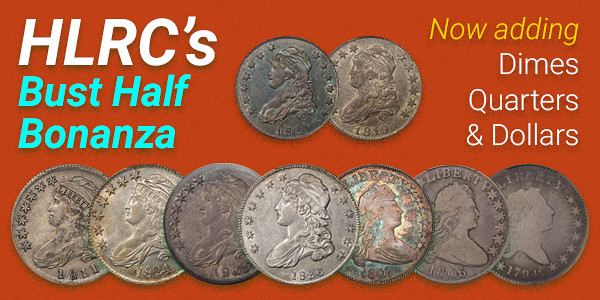
NEW BOOK: COIN YEARBOOK 2020
Token Publishing has produced a new edition of their coin yearbook. -Editor
 The COIN YEARBOOK 2020 is out now - we completely
sold out of the ones we took to COINEX last weekend but our printer is working hard (or so they say) to get us more copies by the end of the week! Once again priced at just £9.95
this critically acclaimed price-guide and Collectors' handbook is the perfect companion for serious numismatists, casual coin collectors, metal detectorists or even those just
with some coins to value - order your copy today!
The COIN YEARBOOK 2020 is out now - we completely
sold out of the ones we took to COINEX last weekend but our printer is working hard (or so they say) to get us more copies by the end of the week! Once again priced at just £9.95
this critically acclaimed price-guide and Collectors' handbook is the perfect companion for serious numismatists, casual coin collectors, metal detectorists or even those just
with some coins to value - order your copy today!
For more information, or to order, see:
Coin Yearbook 2020 (https://www.tokenpublishing.com/shop/product/8025/16)

BOOK REVIEW: EARLY DATED COINS OF EUROPE, 2ND ED.
In the December 2019 issue of The Mint Master from the Utah Numismatic Society, Doug Nyholm published this review of the Second Edition of The Early Dated Coins of Europe, 1234-1500 by Robert A. Levinson. With permission, we're republishing it here. Thanks. -Editor
EARLY DATED COINS OF EUROPE 1234-1500 / 2ND EDITION
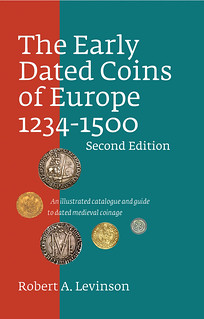 I recently
received the updated 2nd edition of this book which is now in full color. The first edition was published in 2007 and has become the benchmark for these coins. You may ask why a
second edition, aren't all of these early coins accounted for and known? The answer is no, this edition contains over 150 new pieces and there are now over 1250 known types
and subtypes listed for these early interesting coins. Additionally, there are over 500 updates and more than 200 new photographs.
I recently
received the updated 2nd edition of this book which is now in full color. The first edition was published in 2007 and has become the benchmark for these coins. You may ask why a
second edition, aren't all of these early coins accounted for and known? The answer is no, this edition contains over 150 new pieces and there are now over 1250 known types
and subtypes listed for these early interesting coins. Additionally, there are over 500 updates and more than 200 new photographs.
I don't collect these early dated coins although at one time I did posses a 1499 dated coin. I have however always been interested in just how early the dating of coins went. Have you ever come across that Scheckel dated 45 B.C.? That is a often heard joke regarding coins dated B.C. and of course that couldn't happen. According to Robert Levinson's book the earliest dated coin is 1234, still quite old. The dating of early coins was quite sporadic however.
The book contains an 18-page introduction which made fascinating reading and was a mini-college course regarding early European coinage. The 1234 Roskilde bishopric denier from Denmark holds the honor of being the first dated coin. Interestingly the next dated coin wouldn't appear for another 138 years and carry the date 1372. The idea that coins should be dated was not widespread in Europe until the late 16 th century and didn't become widespread or somewhat universal until the early 19 th century. Many early coins were identified not by exact date but generalized as to the reign of the King or ruler depicted on the coin.
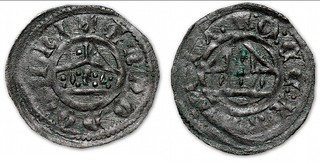 As far as collecting these early dated coins especially
the early ones it becomes quiet a challenge, sometimes virtually impossible. The 1234 dated coin is known to the extant of 8 specimens all of except a single coin impounded in
museums. The 1374 Aachen groschen is effectively the first collectable dated coin as the 1372 coin or 1373 coin are all also in museums. For the next 50 years examples of the
Aachen coinage are available at times.
As far as collecting these early dated coins especially
the early ones it becomes quiet a challenge, sometimes virtually impossible. The 1234 dated coin is known to the extant of 8 specimens all of except a single coin impounded in
museums. The 1374 Aachen groschen is effectively the first collectable dated coin as the 1372 coin or 1373 coin are all also in museums. For the next 50 years examples of the
Aachen coinage are available at times.
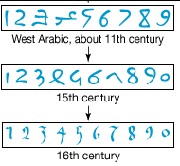 The date as it appears on these early coins is
also not what you think it is if you are referencing modern coinage and Arabic dates. Many times, the date would appear in Arabic, or Roman Numerals or even a combination of both.
Additionally, the date would sometimes be abbreviated from the standard four digits to 3, or 2 and even as a single digit. Also the numbers during the medieval times varied from
the way we wright them today.
The date as it appears on these early coins is
also not what you think it is if you are referencing modern coinage and Arabic dates. Many times, the date would appear in Arabic, or Roman Numerals or even a combination of both.
Additionally, the date would sometimes be abbreviated from the standard four digits to 3, or 2 and even as a single digit. Also the numbers during the medieval times varied from
the way we wright them today.
Much more information if available in this book and if your interested I suggest that you acquire a copy for yourself. It is available directly from the Coin & Currency Institute for $88.95. It is not an inexpensive book but it does have a wealth of very interesting information. It is 330 pages 8 ½ x 11 format in full color.
To read the earlier E-Sylum article, see:
NEW BOOK: EARLY DATED COINS OF EUROPE, 2ND ED (https://www.coinbooks.org/v22/esylum_v22n37a03.html)
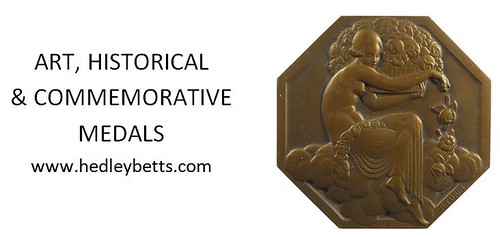
E-GOBRECHT EDITOR BILL BUGERT STEPS DOWN
Congratulations are due to Bill Bugert, who stepped down after 15 years as editor of The E-Gobrecht, Liberty Seated Collectors Club's electronic newsletter. Here's his final editor's note. -Editor

This is my last issue as the E-Gobrecht Editor-Publisher. Long time club member Paul Kluth will assume the Editing-Publishing of the E-Gobrecht beginning with the next issue. After 15 full years and 179 monthly issues, it is time to turn over this responsibility to new energy and fresh ideas.
I wish to thank Paul for taking on this duty. Paul is new to retirement from his careers and now has time to continue supporting the Liberty Seated Collectors Club in different ways. Besides authoring numerous articles for the club publications, Paul routinely helps the club to liaison with local clubs and assists at manning club tables at shows. He will now have the E-Gobrecht also.
It has been my privilege and pleasure to publish the E-Gobrecht since January 2005 after club member Michael Fey approached John McCloskey and I with this idea at the Fall 2004 Baltimore show. With no club email address listing and no authors, I took on this challenge. With a slow start, it is now a nationally recognized award winning publication. This is due to the huge support I received over the years and I sincerely want to thank the club membership. Numerous individuals, far too many to specifically mention, all helped me make the E-Gobrecht a success. Most notably and recently, this newsletter would not have been worthwhile without the columnists, Len Augsburger, Craig Eberhart, Dennis Fortier, and Greg Johnson. John Frost always provided great support and I am truly thankful to all these individuals and to many others. I know Paul with continue and surpass this success.
Lastly, I know you, the LSCC members, will continue to support Paul in future issues. Without submissions, the newsletter is not newsworthy. I will continue to be the Gobrecht Journal Editor-Publisher.
Good luck to new editor Paul Kluth. -Editor
For more information on the Liberty Seated Collectors Club, see:
http://www.lsccweb.org/

GARY LEE PATTERSON (1939-2017)
David Gladfelter submitted this obituary of author Gary Patterson of New Jersey. Thanks. -Editor
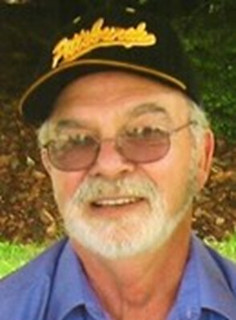 We recently learned of the recent death of Gary
Lee Patterson, a charter member of the New Jersey Exonumia Society (NJES) and longtime editor of its quarterly publication, Jerseyana. He was 77.
We recently learned of the recent death of Gary
Lee Patterson, a charter member of the New Jersey Exonumia Society (NJES) and longtime editor of its quarterly publication, Jerseyana. He was 77.
Gary worked for 40 years as a meat cutter for retail stores and military commissaries in New Jersey and Massachusetts, retiring in 2001. He was born in Altoona, Pa., and is buried in the veterans memorial cemetery in North Hanover Township, Burlington County, New Jersey.
 Gary published three major token
and medal catalogs. His 310 page United States Swastika Tokens, Medals, Watch Fobs and Good Luck Charms, 1907-1936 received a third place Mishler Cataloging Award from the
Token and Medal Society (TAMS) in 2009. This was followed by a short supplement about 2011. Gary pointed out that "you will need to educate some people that these tokens and
symbol were used for ‘Good Luck' and had nothing to do with the Nazi use of the swastika." Gary's collection has been consigned for sale to Steve Hayden.
Gary published three major token
and medal catalogs. His 310 page United States Swastika Tokens, Medals, Watch Fobs and Good Luck Charms, 1907-1936 received a third place Mishler Cataloging Award from the
Token and Medal Society (TAMS) in 2009. This was followed by a short supplement about 2011. Gary pointed out that "you will need to educate some people that these tokens and
symbol were used for ‘Good Luck' and had nothing to do with the Nazi use of the swastika." Gary's collection has been consigned for sale to Steve Hayden.
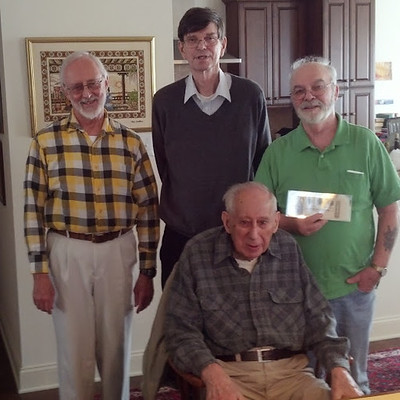
New Jersey Exonumia Society old timers: Standing from left: David Gladfelter, Bob Schopp, Gary Patterson; Seated: Al Zaika. Gary is holding a set of scrip notes from his home town of Manchester, N. J.
In 2007 R. W. Colbert made for Gary a unique hand-engraved personal swastika token with his initials on both sides. Since this token is not in the catalog, it is illustrated here.

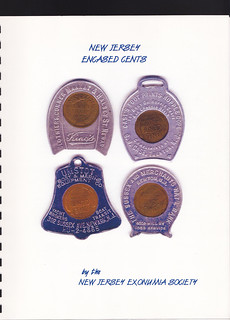
Prior to that, Gary published The Whitehead & Hoag Co., Newark, N. J., Storecards, Tokens, Medals, Tags and Watch Fobs, the result of many years of collecting, research and correspondence with fellow collectors. Gary also catalogued New Jersey Encased Cents, a joint effort with James Treadway, the late Dave Wilson, Rocco DiGiacomo, Bob Slawsky and the late Al Zaika, which was published by the New Jersey Exonumia Society. All of the foregoing catalogs are well illustrated.
In December, 1979, TAMS published Part 1 of Gary's catalog of New Jersey food stamp tokens. Part 2 was published in October, 1980, by the Food Stamp Change Newsletter, a short-lived venture by Jerry P. Schimmel undertaken as the U. S. Department of Agriculture was ending the use of tokens in its food stamp program. Al Zaika continued the list of New Jersey food stamp tokens which has not yet been published.
Gary was a frequent speaker at coin clubs throughout New Jersey and in Pennsylvania and Delaware on a variety of token and medal topics, until health problems curtailed his travel.
Surviving are his wife of 54 years, Lois; two sons, Gary of Manchester and David of Standish, Maine; a daughter, Shannon of Sharon, N. H.; a brother, Eldon of Duncansville, Pa.; a step-brother, the late Alfred Stanslaw of Altoona who passed away two weeks ago; a step-sister, Kay Ann Burkett of Altoona; two grandchildren and two great-grandchildren.
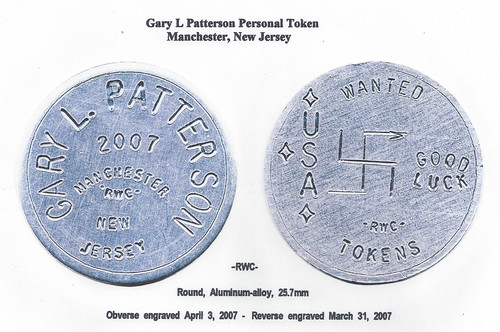
Gary's research and publishing efforts were groundbreaking in the exonumia field. He will be missed, but his contributions to the hobby live on. -Editor

CHRISTMAS COINS ON THE NEWMAN PORTAL
Newman Numismatic Portal Project Coordinator Len Augsburger provided this holiday report. Thanks. -Editor
Christmas Coins
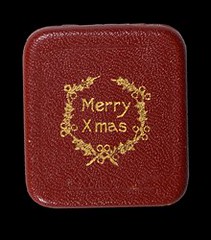
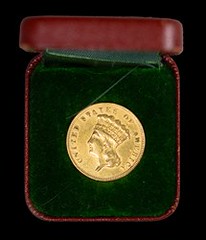
A sadly obsolete tradition is the presentation of gold coins at special events, most often in conjunction with the end-of-year holidays. This was a practice not only for numismatists, as many non-collectors gave gifts of gold coins when these pieces were in circulation. Today these gift coins are widely dispersed, but what has survived are the presentation cards and boxes that once delivered such holiday surprises. A few of these are found in the Eclectic Numismatic Treasure collection and can be viewed on Newman Portal.
A few echoes of this tradition appear now and again. Salvation Army buckets, especially in the Chicagoland area, receive gold coins (typically American Gold Eagles) on an annual basis. The writer's spouse was presented with a Swiss gold coin on the occasion of a service anniversary with a Swiss-owned firm. E-Sylum readers may also wish to pick up the December/January issue of COINage magazine, which features an article by Tom DeLorey entitled "Holiday Season Money Gifts: Christmas, Hanukkah and the New Year Are Opportune for Giving Money."
Image: Presentation holiday box for gold coin, from the Eclectic Numismatic Treasure collection.
Link to numismatic Christmas cards from the Eclectic Numismatic Treasure collection on Newman Portal:
https://nnp.wustl.edu/library/imagecollection/511173
MORE ON THE COIN PETTING ZOO
E-Sylum reader Tom Babinszki publishes the Blind Coin Collector blog. His latest post is a great follow-up to two earlier E-Sylum articles related to the coin petting zoo organized by the Lawrence University classics department. Here's an excerpt, but be sure to read the complete article online. -Editor
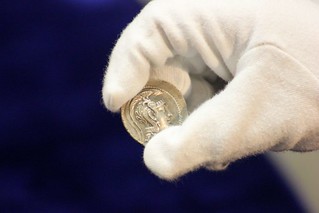 I read an article in the October 27,
2019 E-Sylum about an annual coin petting zoo organized by the Lawrence University classics department and the Wriston Art Center Galleries in Appleton, Wisconsin. The idea
fascinated me, because it was a hands-on experience with coins, and had absolutely nothing to do with blind people. When I talk to coin collectors, I often encourage them to
experience coins by touch when it is possible. Traditionally we can see coins in holders or behind glass, but there is still many to be handled especially when using a proper
protection of objects.
I read an article in the October 27,
2019 E-Sylum about an annual coin petting zoo organized by the Lawrence University classics department and the Wriston Art Center Galleries in Appleton, Wisconsin. The idea
fascinated me, because it was a hands-on experience with coins, and had absolutely nothing to do with blind people. When I talk to coin collectors, I often encourage them to
experience coins by touch when it is possible. Traditionally we can see coins in holders or behind glass, but there is still many to be handled especially when using a proper
protection of objects.
After reading about the coin petting zoo, I was curious how it came about, and I wanted to see what we can learn from this experience either for collectors in general, or if there is something that can be adopted for blind people to learn about numismatics. I contacted Adriana Brook, a professor of classics, from Lawrence University's classic department with my questions. She responded promptly and suggested that I also contact Beth Zinsli who is the curator of this collection.
As I was researching this topic, I also came across another article from the E-Sylum, which talks about the collection and Ottilia Buerger, a Lawrence University alumna, who donated it to the University. I will not rewrite this information here, but I would recommend that you read it with this post, it is a great piece.
I originally wanted to write this post in an interview style, and I sent a few questions to Adriana and Beth. Their response was so great, if I converted it into a different format it would only lose from its value, so the following is a slightly filtered version of the emails I got in response to my questions. Beth Zinsli mostly told us about the history of the collection, and Adriana Brook gave an overview of the coin petting zoo and explained how she is using it in her classes.
From my perspective as a professor there are several aspects of the ancient coin petting zoo that I consider to be particularly successful. First, it allows students to engage with the field of classics in a tangible way that's often lacking – for good reasons – in classes that focus on the ancient past. Students read heavily edited texts that somebody else has translated or look at pictures of famous, well-preserved (often restored) artifacts of the past. When students engage with the past in this somewhat distanced way, it's really easy to lose sight of the fact that our connection to the ancient world is often really tenuous.
When students engage with the coins in 3D they have to contend with uncertainty: the coins are worn away in places; they may be cast asymmetrically, leaving partial words or images; there's no authoritative textbook to consult to find out what the text says or what the imagery is meant to represent (or sometimes, what a given image is even supposed to be!); some of our coins even contain "typos." Uncertainty can be an uncomfortable experience, but it offers a valuable perspective on the role that historians, archaeologists, and textual critics play in creating the body of knowledge that students come into contact with in classics courses.
To read the complete article, see:
Coin petting zoo at the Lawrence University
(https://blindcoincollector.com/2019/12/08/coin-petting-zoo-at-the-lawrence-university/)
To read the earlier E-Sylum articles, see:
THE ANCIENT COIN PETTING ZOO (https://www.coinbooks.org/v22/esylum_v22n43a20.html)
OTTILIA BUERGER'S ANCIENT COIN COLLECTION (https://www.coinbooks.org/v22/esylum_v22n47a11.html)

NOTES FROM E-SYLUM READERS: DECEMBER 8, 2019
More on the Steel Cent Webbing
David Lange writes:
Regarding Tom De Lorey's piece about the steel cent webbing, I wrote a column on this subject for The Numismatist that references his comments. It ran in the August, 2015 issue, and it's also reproduced at the NGC website.
Thanks - here's an excerpt and link to the article. -Editor
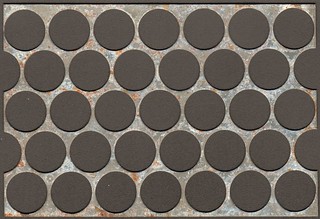 Sold by the mints as scrap material, it never
occurred to anyone at the time that it would have collector value. In researching my book, The Complete Guide to Lincoln Cents, I came across an advertisement in the July
1960 issue of The Numismatist offering these punched strips in six-inch long segments. The price was $5 postpaid, and the seller indicated that he had around 750 pieces
available!
Sold by the mints as scrap material, it never
occurred to anyone at the time that it would have collector value. In researching my book, The Complete Guide to Lincoln Cents, I came across an advertisement in the July
1960 issue of The Numismatist offering these punched strips in six-inch long segments. The price was $5 postpaid, and the seller indicated that he had around 750 pieces
available!
To read the complete article, see:
USA Coin Album: Steel This Cent (https://www.ngccoin.com/news/article/5283/USA-Coin-Album/)
To read the earlier E-Sylum article, see:
1943 STEEL CENT PLANCHET STRIPS USED IN ROOFING (https://www.coinbooks.org/v22/esylum_v22n48a08.html)
Anton Teutenberg and the South Island of New Zealand
Martin Purdy of New Zealand writes:
I'm always amused at what happens to the names of our two largest islands when they're mentioned by folks from other places. The English, for some reason, tend to refer to them as simply "North Island" and "South Island", whereas here they'll always take a definite article: "the North Island", "the South Island". Seeing "the Southern Island" in the quote below is a new one for my list! It's also a little ambiguous when used this way, because there's a third main island that's further south still - Stewart Island, which differs from the other two in not needing a "the", as well as being considerably smaller. (I can hear the voiceover from the opening credits of "Soap" in my mind at this point: "Confused? You will be ...")
"In 1861, gold was discovered in Otago in the Southern Island of New Zealand, touching off a gold rush that drew miners from as far away as California. Rumsey was one of the many Australians who would pull up stakes and head for the gold fields of this island colony."
Auckland's Supreme Court building has another numismatic connection. -Editor
Jim Duncan of New Zealand writes:
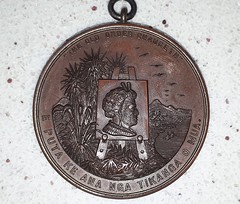 Thanks for the piece
about Edward Rumsey and his gold medal (the Eimer reference is 1306-B). He was responsible for the design of Auckland's Supreme Court building, which is heavily decorated by a
German who came here in 1866 as an engraver! Anton Teutenberg, who was given a block of stone and told to have a go! He did a number of Maori heads, and the Queen and Prince
Albert, and a series of rainhead gargoyles all of which are still in working order. There are around 40 pieces in all.
Thanks for the piece
about Edward Rumsey and his gold medal (the Eimer reference is 1306-B). He was responsible for the design of Auckland's Supreme Court building, which is heavily decorated by a
German who came here in 1866 as an engraver! Anton Teutenberg, who was given a block of stone and told to have a go! He did a number of Maori heads, and the Queen and Prince
Albert, and a series of rainhead gargoyles all of which are still in working order. There are around 40 pieces in all.
Attached is an image of one of his better medals and a fee-gratis genuine Gargoyle. I had the privilege of co-authoring a book on Teutenberg's medallic work, but the stonework gets a mention too.

Thanks, everyone. -Editor
To read the earlier E-Sylum article, see:
EDWARD RUMSEY ROYAL ACADEMY OF ARTS GOLD MEDAL (https://www.coinbooks.org/v22/esylum_v22n48a23.html)
Query: The Sign of the 8
Regarding a Civil War token design illustrated last week, James Higby writes:
I, too, have puzzled over the significance of "Sign of the 8." Some time ago I found this ad on newspapers.com. It's for a business other than the one on the store card. I don't remember exactly when or where I found it. Or perhaps someone sent it to me.


Wickersham ad and Preston Civil War token
Scorpio is the eighth astrological sign in the Zodiac, but that may have nothing to do with this. If multiple merchants used this phrase there must have been some commonly understood meaning at the time. Can anyone help? -Editor
To read the earlier E-Sylum article, see:
NUMISMATIC NUGGETS: DECEMBER 1, 2019 : "Sign Of The 8" Civil War Token
(https://www.coinbooks.org/v22/esylum_v22n48a19.html)
Tiffany Medals
Tony Terranova writes:
Tiffany also was a prolific medal producer, with many in gold and silver.
To read the earlier E-Sylum article, see:
TIFFANY AND THE GREAT SEAL OF THE U.S. (https://www.coinbooks.org/v22/esylum_v22n48a30.html)
Request for Assistance: Billon Beshlyks Issued by the Giray Khans of Crimea
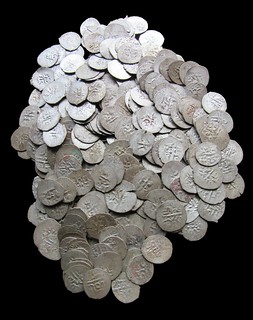 Eric Schena writes:
Eric Schena writes:
I am finishing up an article about a possible hoard of mid-eighteenth century billon beshlyks issued by the Giray Khans of Crimea. I would love to have someone who is knowledgeable on the subject have a look and basically fact-check what I have written and see if there are any errors, especially in attribution. These coins are notoriously hard to pin down due to the crude strike and having a second pair of eyes on it would be quite helpful before I try to have it published. If anyone is willing to have a look and provide feedback, they can contact me at my email address. Proper credit will be given.
Can anyone help? Eric's address is eschena@hotmail.com -Editor

MORE ON THE MINT'S MANUFACTURED RARITIES
Vic Mason submitted these additional thoughts about the Mint's new circulating rarities. Thanks! -Editor
CONCERNS ABOUT THE ETHICAL DISTRIBUTION OF THE HIGHEST-GRADE CIRCULATING RARITIES THAT ARE NOW BEING INTENTIONALLY PRODUCED BY THE UNITED STATES MINT
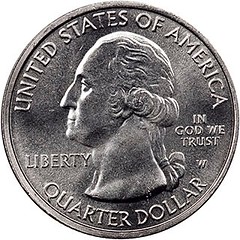 I hope that when the first copies of the 2019 "W" quarters were made this year at the West Point Mint, the supervisory staff and production
staff of the United States Mint saved at least one copy each for themselves (given the historic nature of the enterprise), as "25-cent souvenirs, hot off the press," so to speak.
I say "hope" because, unless they did, there are likely to be virtually no Mint State 69 or 70 survivors of those five production runs of the Lowell, Northern Marianas, Guam, San
Antonio, and Frank Church Wilderness quarters. The only exceptions I can think of are those intentionally set aside for the National Numismatic Collection of the Smithsonian
Institution.
I hope that when the first copies of the 2019 "W" quarters were made this year at the West Point Mint, the supervisory staff and production
staff of the United States Mint saved at least one copy each for themselves (given the historic nature of the enterprise), as "25-cent souvenirs, hot off the press," so to speak.
I say "hope" because, unless they did, there are likely to be virtually no Mint State 69 or 70 survivors of those five production runs of the Lowell, Northern Marianas, Guam, San
Antonio, and Frank Church Wilderness quarters. The only exceptions I can think of are those intentionally set aside for the National Numismatic Collection of the Smithsonian
Institution.
If they did save some for themselves, they do not realize – except for the coin collectors among them – that they are likely in possession of some of the "hottest" rare coins that have ever been produced (inadvertently) by the United States Mint. Judging by the extraordinary four-, five- and even six-figure auction prices achieved by modern-coin condition rarities in recent years, such innocently- saved pristine "W" quarters could, if properly handled, end up going for auction prices that make their owners' heads spin. That's because the manner of production and distribution of the 2019 "W" quarters was to put virtually all of them directly into circulation throughout the country and the territories.
Those few carefully-handled coins that, as a matter of custom, go to the Smithsonian – two of each quarter design? – become extraordinary treasures, unbeknownst to the leaders of the United States Mint. That's why the Mint supervisory staff, for their own sakes, need the assistance of a public- private partnership (PPP) from the numismatic industry to provide the guidance that keeps everything in the production and distribution of these coins above-board and transparent. Leaders from the Mint and from the United States Department of the Treasury are unlikely to understand the significance of a term like "condition rarities," as it applies to these new deliberately-created circulating rare coins.
We know that the Mint staffers have developed plenty of experience and expertise in recent decades, using the most modern high-tech equipment, to produce perfect coins and thus meet collector demand for specimens at the 69- and 70-grade levels. But they are unlikely to understand that it's not just the number that gives the coins their desirability to collectors. It's the combination of the rarity of the coins and the frenzy of today's collectors putting together "registry sets" – another concept foreign to the non-collector. The collecting community – probably unaware of that lack of sophistication among Treasury and Mint staff – could once again become cynical about the whole program, if they thought "insiders" were operating for their own advantage.
So the Mint's leaders need the PPP to provide expert guidance in the setting of policy on the new circulating rarities – for example, those coins saved for notables and those inserted into cereal boxes or other packages of consumer commodities for the general public to search for. Those pristine specimens will predictably be at the very top of every collector's wish list. That is why I think the circulating rarities being sent to the Smithsonian should first be graded and encapsulated by third-party grading firms – so that no one "in the know" could slip lightly-circulated substitutes into that collection to replace perfect but uncertified specimens.
These are just some thoughts I've mulled over recently, as policy and practice in these exciting new areas of coin collecting, grading, production and distribution evolve.
To read the earlier E-Sylum article, see:
BENEFITS OF THE 2019-W QUARTERS PROGRAM (https://www.coinbooks.org/v22/esylum_v22n27a16.html)
VIC MASON'S THOUGHTS ON U.S. MINT FORUM (https://www.coinbooks.org/v22/esylum_v22n45a14.html)
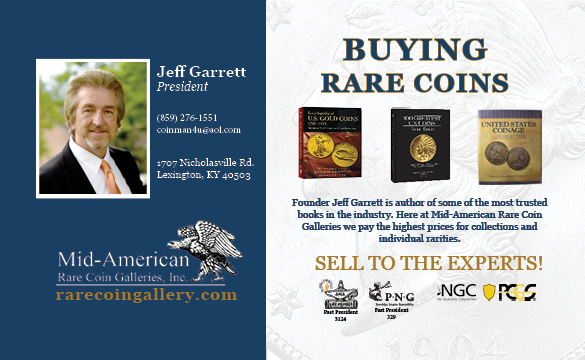
WHITMAN COIN COLLECTOR CARDS POSTER SURFACES
Author and researcher David Lange publishes Coin Board News, an electronic publication for collectors of coin boards and related hobby supplies. In the Winter 2020 issue he published an image of a great poster advertising the Whitman coin boards (called "Coin Collector Cards" at the time). With permission, we're republishing it here. -Editor
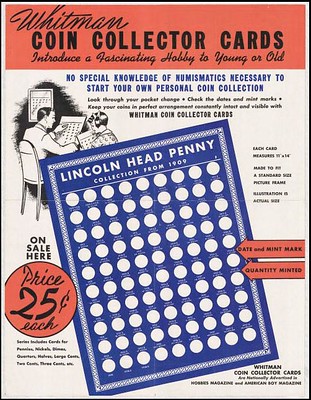 I frequently do internet
searches on terms such as coin board, pennyboard, etc. These usually direct me to eBay listings I've saved already, but every now and then I find something truly
exciting. That was certainly the case when I came across this gem:
I frequently do internet
searches on terms such as coin board, pennyboard, etc. These usually direct me to eBay listings I've saved already, but every now and then I find something truly
exciting. That was certainly the case when I came across this gem:
Yes, no one in coin board hobby has ever seen or reported this vintage poster until now. Yes, I immediately wrote to the website holder to see if I could buy it or trade for it. No, it's not for sale. This poster is part of an institutional collection and will likely never be for sale. The only question remaining is whether another exists anywhere. This rare jewel features Second Edition board W1¢D2f, with dates through 1938 and mintages through 1937.
For more information on Coin Board News, see:
http://www.coincollectingboards.com/

VOCABULARY TERM: ORIENTATION
Dick Johnson submitted this entry from his Encyclopedia of Coin and Medal Terminology. Thanks. -Editor
Orientation. Adjusting or rotating a numismatic or medallic design so the horizontal and vertical planes are appropriate to the viewer. This is required at several times; when the artist designs the piece, of course, when the pressman prepares his setup for striking – DIE ALIGNMENT – and when an illustration is prepared for publication. This is mostly a problem for illustrations of round coins and medals so they won't look tilted.
How to orientate round coin and medal illustrations. When coins or medals are designed, artists use obvious and subtle hints to give the viewer a perception to which way is up ... or down ... on a round design. Obvious hints are horizon lines, water lines, bases and sides of buildings and such. In numismatics we have a very often used element – the base line – which separates the design from the exergue. If a base line is present it is easy to orientate a numismatic illustration.
Most important hint of all: inscription lettering is always on a horizontal base line. Other subtle hints include: the legend – the lettering around the circular edge – usually starts and stops at the same level.
For items designed with linear perspective there are numerous clues for orientating a coin or medal: two eyes of a portrait are usually on the same level plane. The shoulder line is usually level. A profile is usually vertical.
Also look for vertical lines: sides of buildings, coats of arms, logos, trees, columns, candlesticks. Everything that should look vertical in nature – should look vertical on a coin or medal design.
In the days when all illustrations were mounted on wooden printing blocks this chore was done by the photo engraver (who mounted the zinc cut). Today it is done by the makeup artist or the layout artist. There is no excuse today to have tilted illustrations because of the ease in which they can be aligned.
Looking for the meaning of a numismatic word, or the description of a term? Try the Newman Numismatic Portal's Numismatic Dictionary at: https://nnp.wustl.edu/library/dictionary
Or if you would like a printed copy of the complete Encyclopedia, it is available. There are 1,854 terms, on 678 pages, in The Encyclopedia of Coin and Medal Technology. Even running two a week would require more than 19 years to publish them all. If you would like an advance draft of this vital reference work it may be obtained from the author for your check of $50 sent postpaid. Dick Johnson, 139 Thompson Drive, Torrington, CT 06790.
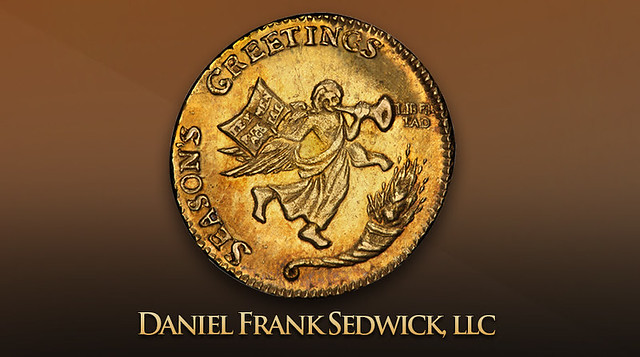
WINSOR, RICHARD BROWN (1848-1889)
Winsor, Richard Brown (1848-1889), he was born on May 25, 1848, the son of Andrew Winsor (1818-1883), and Mary Jane Brown (1821-1904), and was named after his maternal grandfather Richard Brown. He was a descendant of Joshua Winsor of Providence in 1638 and also of "the Brown Family" with direct lineage to Chad Brown a colonial committee-man at Providence in 1640. He graduated Providence Public High School in the Classics Department in 1864. He graduated Brown University in 1868 with an M.A. He was a member of the Zeta Psi Fraternity. His maternal ancestry to Nicholas Brown made Richard Brown Winsor in the bloodline of the namesake of Brown University when it was renamed in 1804 from its original appellation: The College in the English Colony of Rhode Island and Providence Plantations.
He was a member of the Franklin Society and of the Franklin Lyceum. He followed in his father's business as a lumber dealer and bookkeeper in the family firm of Winsor & Brown, Broad Street, corner of Pearl, Providence, Rhode Island, which was first established in 1854 on Hill's Wharf, Providence, Rhode Island, with his father Andrew and his brother-in-law Joseph Farnum Brown. Brown sold out in 1856 moving to Michigan, but was later reunited in the firm once again as a copartnership with Andrew Winsor and Joseph Farnum Brown, re-established in August 1865. After the death of Richard Brown Winsor in 1889 the firm was renamed by Richard's younger brother Andrew (1852-) in 1890 as Andrew Winsor & Company, Lumber Merchants.
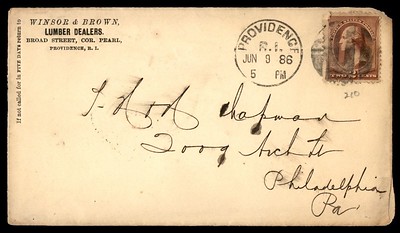
Richard Brown Winsor's business envelope postmarked June 9, 1886, just three and a half years before his demise.
Three of his U. S. large cents were cited in the SS. Crosby and J. N. T. Levick plate and census of 1793 published inAmerican Journal of Numismatics, Volume III, No. 12, April, 1869. In that photographic plate his cents were Nos. 6, D, and 11, with the latter being the finest known uncirculated broken die Liberty Cap from the Mickley sale in 1867, lot 1934, purchased at $37.50. Also, at the Mickley sale he purchased other all uncirculated cents including lot 1954, a 1795 thick planchet lettered edge for $11; lot 1962, a 1796 fillet head for $17; lot 1972, a 1798 for $17; lot 2020, an 1822 for $1.75; and lot 2748, a collection of 62 Hard Times Tokens for $11. The priced and named catalogue for the Mickley sale misspelled Winsor as Windsor.
Two years later he purchased two coins for $47.00 : 1791 Small Eagle Washington Cent for $27.00 and the Washington 1805 Medal by Eccleston for $20.00 at the MacKenzie Sale in New York held by Ed Cogan on 9 June, 1869. In 1875, he was a subscriber to Crosby's Early Coins of America. In 1885 he joined the Rhode Island Historical Society.
Richard Brown Winsor died on December 5, 1889. Six years after his death his coin collection was sold posthumously by the family estate. His collection of 1353 lots was sold by the Chapman brothers on December 16-17, 1895. It contained 180 large cents including the NC-2 "Strawberry Leaf" variety, discovery coin. The Chapman sale of the Winsor collection realized $20,000.
To read the complete article, see:
WINSOR, RICHARD BROWN
(https://sites.google.com/a/numismaticmall.com/www/numismaticmall-com/winsor-richard-brown)
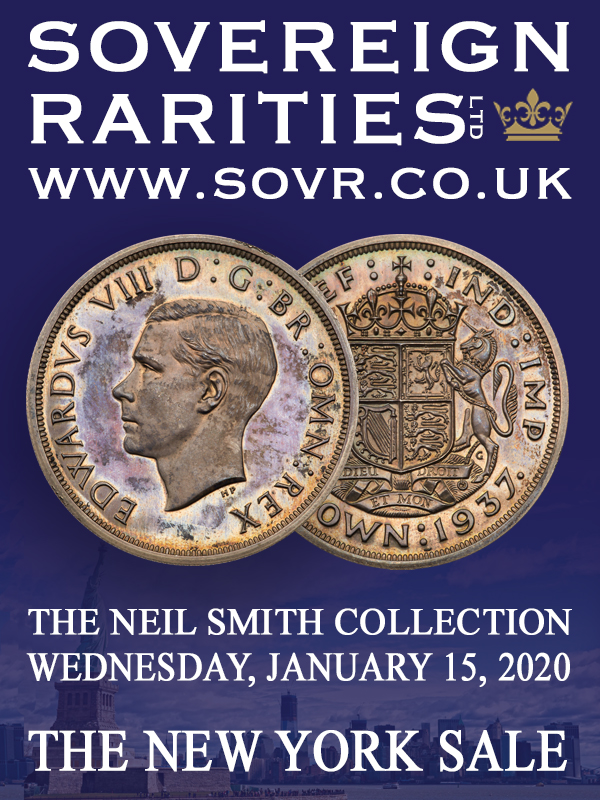
HARVEY STACK'S NUMISMATIC FAMILY, PART 58
The latest article in Harvey Stack's blog series is about hobby growth in 1972 and Louis Eliasberg's collection exhibit. -Editor
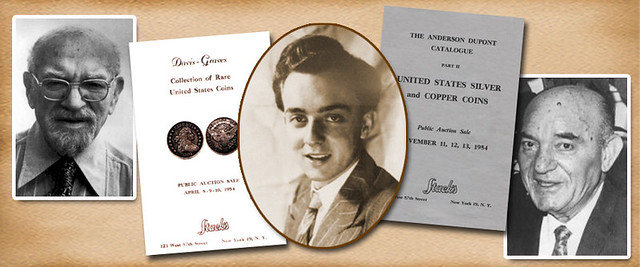
The year 1972 continued some of the trends of earlier years in the hobby. Inflation entered our hobby in force and demand for coins exploded. The American Numismatic Association (ANA) got many new members, as did the Professional Numismatic Guild (PNG). Coin newspapers, especially the weekly editions, added many subscribers, and local clubs developed or expanded their membership.
The price of gold and silver kept advancing, even after President Nixon in 1971 raised the value of gold from $35 to $42 (a result of the inflationary happenings in investment markets). Of course the cost of living advanced as well. The government agencies involved with various market and economic conditions tried in vain to keep markets level. Many people who invested in commodities, the stock market and real estate, also looked for alternate places to invest.
Collecting coins was written about in newspapers and magazines, and, as noted, the number of subscribers to numismatic publications grew. People searched through change for coins made of silver for their metal value and many expanded this interest in investing in metal to collecting other coins. Some bought albums, like those sold by Whitman Publishing Company in order to see how many different dates and mints they could find. More and more collectors grew from beginners into more involved collectors and some became very advanced.
As often happened in a growing field, new buyers could easily be taken advantage of by those selling overgraded, polished, altered, misattributed, or counterfeit coins. The possibility of high profits meant that charlatans could outnumber the qualified dealers in the coin market. The ANA and PNG were aware of this and each organization held many meetings to try to combat the problem, as the negative attention that these problems attracted was detrimental to the hobby. They knew that they did not have the ability to check out every "Mom and Pop" store or flea market vendor in order to guarantee genuineness. They required help, and learned that early the following year the government would be having hearings to see if there was legislation that should be passed to stop the counterfeiters from peddling false or altered coins nationwide.
A SPECIAL REQUEST BY LOUIS E. ELIASBERG
As most collectors know, Louis E. Eliasberg built the only complete collection of United States gold, silver and copper coins ever assembled. He started with some more common
issues and then bought, through Stack's, the famous Clapp Collection. Clapp of Washington, DC, was a banker who had the opportunity to bid on rare coins sold in previous
decades from many famous pedigree collections. When the bank administrated the Clapp estate, Stack's was asked if they could find a buyer. One person who came to mind was
Louis Eliasberg.
Mr. Eliasberg had the financial ability to think about assembling a complete collection of United States coins. My Uncle Joseph and my father, Morton, went to Baltimore and outlined the Clapp Collection to him; he said he would need a few days to think about it. Joseph and Morton told him the ownership of the collection would bring him much closer to his goal of owning every U.S. coin. He decided in one day to go ahead with the purchase of the collection and Stack's negotiated a final sale with the Washington D.C. bank that was the executor of the Clapp Estate. The agreed price was $100,000, plus a $10,000 commission to Stack's. The deal was the largest of its type that had ever occurred.
During the years after World War II, Eliasberg wanted to exhibit his collection as much as he could. Many a bank opening or other celebration in the Maryland area had the good fortune of exhibiting the Eliasberg Collection. The fame of the collection grew nationwide and it was featured in many well-known magazines, and highlighted on the front covers of some. Besides his United States coin collection, Louis E. Eliasberg also assembled a collection of gold coins of the world, thinking that gold was the major commodity that gave currency its value. He had a great interest in monetary history and wanted his collection to teach about the economics of gold. These coins were also exhibited and used as an educational tool. In addition, Mr. Eliasberg was a member of many coin clubs and would show his rarities there and give numismatic lectures.
In 1972, Louis E. Eliasberg called our offices in New York and said he wanted a new inventory made of his collection along with some sort of evaluation. He was getting older and unfortunately sick , and he wanted to be sure his collection would continue to be on exhibit, and eventually sold. Norman and I went to Baltimore in 1972 to do this job and during our time there, Lou (as we knew him well enough to call him) discussed the idea of selling his collection, intact, to a single wealthy individual or to a financial or other important company, with the thought that it would be displayed around the country and used for advertising and education. Eventually, he thought, the collection would be sold again. He also had thoughts of exhibiting the collection nationwide using the railroad system and setting up the exhibit in railroad cars that could be visited when the train stopped in stations. This had been done successfully with collections of art, antiques and historical items, but never in numismatics. His health situation precluded him doing such a tour at that time.
After completing our project for Mr. Eliasberg, Norman and I went back to New York with his ideas on our mind. We tried to sought out a resolution to his problem, but initially were unsuccessful.
To read the complete article, see:
Harvey Stack Remembers: Growing up in a Numismatic Family, Part 58
(https://www.stacksbowers.com/News/Pages/Blogs.aspx?ArticleID=harvey-stack-remembers-58)
To read the earlier E-Sylum article, see:
HARVEY STACK'S NUMISMATIC FAMILY, PART 57 (https://www.coinbooks.org/v22/esylum_v22n46a13.html)
THE BOOK BAZARRE
ARTICLE PROFILES MEDAL DESIGNER CHESTER MARTIN
Greg Burrus of Chattanooga writes:
As a graduate of the University of Tennessee, Chattanooga I receive their magazine. Their latest issue has a story about Chester "Marty" Martin, a fellow UTC graduate who seems to have enjoyed a long numismatic career. Though I don't know the gentleman, I felt the article was interesting enough to pass on.
Thanks! Profiles of coin and medal designers are often found far outside of the numismatic sphere. Here's an excerpt. I added an image of the General Colin Powell Congressional Gold Medal obverse. See the complete article online for more. -Editor

The three-ring binder is as thick as a Bible with both Old and New Testaments.
In it is the life of Chester "Marty" Martin, who graduated from the University of Chattanooga in 1962, toting a diploma for a degree in art. Inside the binder are handwritten letters from, among many others, artists Andrew Wyeth and Norman Rockwell and the directors of the Smithsonian Institution and the British Museum in London, which have Martin's coins in their world-famous collections.
Martin plans to donate the binder and its historical papers, letters and photos to UTC in the future. "This just pretty much chronicles my professional life," says Martin, 85, who lives with his wife, Pat, in the same Chattanooga house they've lived in for 54 years, moving in two years after they were married.
As he flips through the pages in his binder, his memory is sharper than an engraving tool, and he easily recalls names and places, where this dinner was held, when and where he met this person.
Skilled Artist
It's been quite a life for Martin, who is a painter in both oils and watercolors, a sculptor, a woodcarver and, in perhaps his most notable career, a numismatist or, for those
who don't recognize the word, someone who uses plaster or porcelain to engrave the original artwork that is later minted as coins. "I had to teach myself how to make a coin;
there is not a book that you can find that says how to make a coin. So I had a lot of learning to do," Martin says.
But he learned fast. When he submitted a photo of his first coin engraving to the Franklin Mint in 1966, he received a letter from Joseph M. Segel, founder of the mint, which sells coins, medals, jewelry and other items. "It appears from the picture you sent that you may have the talent necessary to become a fine coin and medal designer," Segel wrote. He was right.
Martin worked at the U.S. Mint in Philadelphia from 1986 until 1992 and, in those years, he engraved or helped design coins for subjects such as commemorating the efforts of singer/songwriter Harry Chapin to end worldwide hunger, the works of artist Wyeth as part of the 100th anniversary celebration Yosemite National Park, the bicentennial anniversary of the U.S. Congress and the reverse side of the White House Bicentennial silver dollar in 1992.
In 1980, on the back of The National Sculpture Review magazine, he saw an ad for the Society of Medalists' 50th anniversary contest. Winning prize was $10,000. Although he'd never worked in metal before, he decided to enter and created a three-inch, circular medal with a snail engraved into it. With a spiral shell, it sits on a spiral-twisted vine and gazes at a spiral galaxy in the sky. It won the contest.
The late George Cress, former head of the UTC Department of Fine Arts, wrote a personal note after Martin gave him a copy of the medal in the early 1980s. "I want to express my appreciation to you for your prizewinning medal for the Society of Medalists," Cress wrote. "I have this on my desk and am pleased to be reminded of your outstanding achievements as one of our graduates."
In 1984, the American Medallic Sculpture Association was asked to supply a medal for the World Food Day contest, the first time such a request had been made of U.S. artists. Martin entered the competition and won.
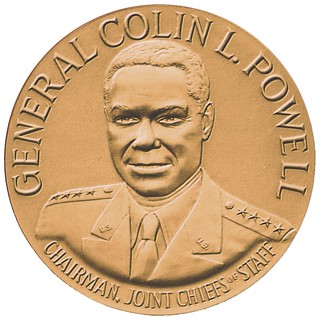 In 1988, he was
hired by the U.S. Mint. One of his personal favorites is the Congressional Gold medal to honor four-star Gen. Colin Powell, commander of American forces in operations Desert Storm
and Desert Shield and former chairman of the Joint Chiefs of Staff. It was the last project Martin did at the Mint.
In 1988, he was
hired by the U.S. Mint. One of his personal favorites is the Congressional Gold medal to honor four-star Gen. Colin Powell, commander of American forces in operations Desert Storm
and Desert Shield and former chairman of the Joint Chiefs of Staff. It was the last project Martin did at the Mint.
"And boy, we worked," Martin says, pointing to the four stars on Powell's shoulders depicted on the coin. "He had to be able to see all those stars; all of them had to show on both shoulders."
The coin's face had Powell's portrait and the reverse showed him talking to a foot soldier. "It's supposed to show some humanity," Martin says.
To read the complete article, see:
COIN ART Alumnus is a Renowned Numismatist
(https://www.utc.edu/magazine/issues/03-01/index.html#book/20)
Colin Powell medal image from:
https://commons.wikimedia.org/wiki/File:General_Colin_Powell
_Congressional_Gold_Medal.jpg

MEDIALIA GALLERY EXHIBITS THRU FEBRUARY 2020
A reception was held Saturday, December 7, 2019 for the opening of two new exhibits at Medialia Gallery in New York. Both will remain open through February 2, 2020. -Editor
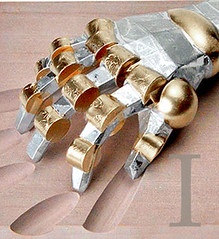 Space I
Space I
New Ideas In Medallic Sculpture
An Annual Traveling Student Exhibition
Featurning students from Daido University and University of Tsukuba
2019-2020 New Voices
Emerging artists from Sofia, Bulgaria and the New Approach collection
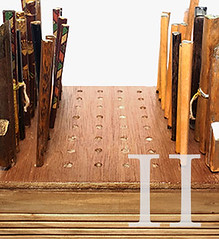
Space II
Chess, Adjustable Objects, & Other Intimate Works
An annual exhibit of intimate hand-held and wearable objects, prints and other wall-hangings
Still on display is the excellent American Medalists in Paris exhibit. -Editor
New Approach Contemporary Medallic Art Research Center
American Medalists in Paris
Curated by Scott Miller from the collections of: Jay Galst, Scott Miller, Ira Rezak, David Simpson, Donald Scarinci, Frederic Withington
For more information, see:
http://www.medialiagallery.com/


SS CENTRAL AMERICA 1856-S/S QUARTERS DISCOVERED
This press release describes the discovery of nine examples of the rare 1856 quarter "S/s" repunched mintmark. -Editor
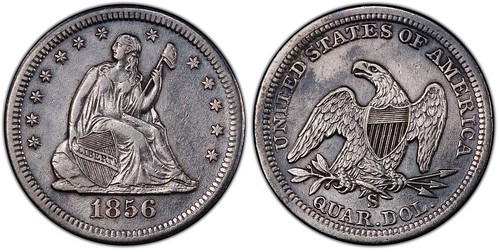
The fabled SS Central America, the famous "Ship of Gold" that sank in 1857 carrying tons of California Gold Rush treasure, continues to surprise and delight the numismatic world. California Gold Marketing Group LLC (CGMG) of Brea, California has confirmed discovery in the ship's latest recovered sunken treasure of nine rare 1856 San Francisco Mint large S over small s mint mark Seated Liberty No Motto quarter dollars.
"This is a major numismatic finding! The ‘Ship of Gold' has brought us over a half dozen 1856 S/s large mint mark over small mint mark silver quarters. The S over s is the most pronounced I have ever seen with two overlapping mint marks clear even to the naked eye. We've nick-named this latest SS Central America discovery as the S over s Central America," said Dwight Manley, CGMG Managing Partner.
"Considering the preponderance of Philadelphia and New Orleans Mint coins found in the recovered treasure, it would appear these came from a batch of coins brought aboard by a miner, and ended up in the safe as did the miners' pokes (packets containing gold and/or coins). What a numismatic miracle to have such a treasure trove aboard the SS Central America," Manley stated.
The coins were part of the amazing treasure retrieved from the SS Central America in 2014. Most of the 1856-S/s coins were among the 503 silver quarter dollars discovered in a canvas bag in the purser's sealed iron box in the ship's safe on the seabed more than 7,000 feet below the Atlantic Ocean's surface.
A lengthy, meticulous, coin-by-coin inspection of the treasure began when CGMG took possession of the 2014 recovery in January 2018, and quarter dollars were among the last of the items to be recently examined.
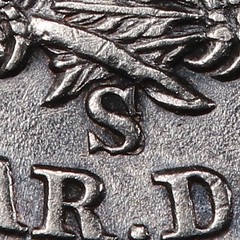 All nine of the 1856-S/s
quarters have now been certified by Professional Coin Grading Service (www.PCGS.com) and each encapsulated with a pinch of California Gold Rush gold dust recovered from the
shipwreck. They will be offered in public auctions by Ira & Larry Goldberg Coins & Collectibles, Inc. (www.GoldbergCoins.com) beginning with the February 16-20, 2020
Pre-Long Beach Auction in Los Angeles.
All nine of the 1856-S/s
quarters have now been certified by Professional Coin Grading Service (www.PCGS.com) and each encapsulated with a pinch of California Gold Rush gold dust recovered from the
shipwreck. They will be offered in public auctions by Ira & Larry Goldberg Coins & Collectibles, Inc. (www.GoldbergCoins.com) beginning with the February 16-20, 2020
Pre-Long Beach Auction in Los Angeles.
With a total mintage of only 286,000, "normal" 1856-S quarter dollars are scarce even in low, circulated grades, and extremely scarce in Mint State grade. Prior to this discovery, PCGS previously certified just 38 examples of the 1856-S/s repunched mint mark, with the majority in only Good to Fine condition and none in Mint State.
These are the grades of the recently certified sunken treasure1856-S/s quarter dollars: PCGS XF45; PCGS XF40; 4 are graded PCGS VF35 and another one is PCGS VF25. Two other coins exhibit environmental damage (PCGS designation 97) and are graded PCGS97-AU and PCGS97-XF.
In addition to the large over small mint mark examples, two, rare mint state "normal" 1856-S quarters were discovered in the treasure; one graded PCGS MS63, the other PCGS MS62.
"Silver coins that were found in the purser's bag in a lock box inside the ship's safe survived 157 years in the Atlantic Ocean without the corrosion seen on most silver coins found on shipwrecks. This is undoubtedly due to the oxygen-starved (anaerobic) conditions within the safe. It was not water tight, but it essentially sealed off the interior environment and its chemistry from the outside seabed environment," explained Bob Evans, the chief scientist on the 1980's mission that first located and recovered a portion of the fabulous sunken treasure and who served in that same role and as a numismatist with the 2014 recovery.
Evans recently found the two 1856-S and nine 1856-S/s quarters while finishing the coin-by-coin examination of the last portion of the treasure.
"The SS Central America has once again revealed another ‘time capsule effect' of what coins were in daily commerce at the time and on the steamship route between San Francisco and New York via Panama in 1857. It is delightful to see this effect yet again in this treasure, as the contemporary usage and details are revealed to us, as if we are transported back in a time machine," said Evans.
The SS Central America was a 280-foot long, three-masted side-wheel steamship carrying tons of California gold that had been shipped from San Francisco to Panama. She sank off the coast of North Carolina on September 12, 1857 during a hurricane while on the final leg of a voyage from Aspinwall (now Colón), Panama to New York City. The loss of the ship's gold cargo was a major factor in the economically devastating financial panic of 1857 in the United States.
In a court-approved transaction in November 2017, the California Gold Marketing Group acquired all the treasure recovered in 2014 from Ira Owen Kane, Receiver for Recovery Limited Partnership and Columbus Exploration, LLC. In 1999, CGMG acquired all of the available S.S. Central America treasure that was recovered in the 1980s.
For more information on the sale, see:
https://www.goldbergcoins.com/

EAGLES OF THE TYRANT COLLECTION EXHIBIT
This press release describes the upcoming Long Beach exhibit of the U.S. $10 gold coins from the Tyrant Collection. -Editor
 A never-before seen exhibit of United
States $10 Eagle gold coins from the extensive Tyrant Collection (www.TheTyrantCollection.com) will be publicly displayed at the February 20-22, 2020 Long Beach Coin, Currency,
Stamp & Sports Collectibles Expo (www.LongBeachExpo.com).
A never-before seen exhibit of United
States $10 Eagle gold coins from the extensive Tyrant Collection (www.TheTyrantCollection.com) will be publicly displayed at the February 20-22, 2020 Long Beach Coin, Currency,
Stamp & Sports Collectibles Expo (www.LongBeachExpo.com).
The unprecedented display, "Eagles of The Tyrant Collection," will showcase examples of every business strike and most of the proof Eagles from 1795 to 1933, including varieties. This unparalleled set will be insured for $50 million for its debut exhibition.
"This is the first collection of gold Eagles to include all 33 BD (Bass-Dannreuther) and T (Taraszka) varieties of 1795 to 1804. Even the famous collections of Harry W. Bass and Anthony J. Taraszka were both short of that goal," said Ira Goldberg, President of Goldberg Coins and Collectibles, Inc. (www.GoldbergCoins.com) in Los Angeles, California.
"There will be more than 300 historic Eagles in this extraordinary exhibit in custom-built, well-lit display cases. They are all part of The Tyrant Collection, the world's most valuable rare coin collection in private hands," explained Goldberg who is among those who have helped the anonymous Tyrant Collection owner build the collection.
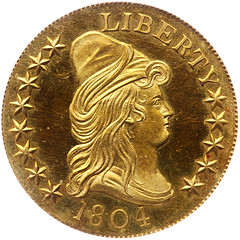
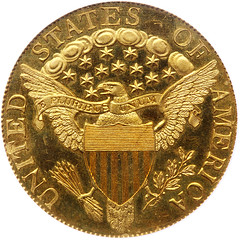
1804 Plain 4 variety $10 gold coin from the King of Siam proof set
The 1804 proof Eagle in the upcoming display is from the legendary King of Siam proof set. The Tyrant Collection holdings include the entire fabled set of coins given by a U.S. State Department representative to the King of Siam (now Thailand) in 1836 as a diplomatic gift on behalf of President Andrew Jackson. That full set will be displayed at a future Long Beach Expo.
Well-known professional numismatist and award-winning researcher and author, John Dannreuther, will assist in the cataloging of The Tyrant Collection Eagles for the upcoming exhibit.
"The early Eagles in the exhibit will be presented in Taraszka order, which is the issuing sequence. Some coins were struck out of date order. For example, both 1798 varieties were struck before the three 1797 Large Eagle varieties. There also is one 1803 variety struck after the 1804 Crosslet 4 variety," explained Dannreuther.
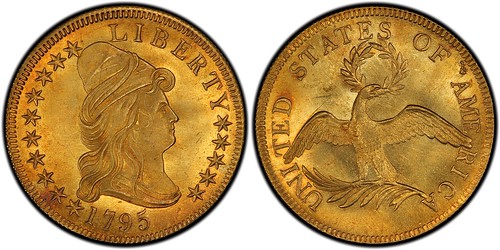
1795 13 Leaves variety $10 gold coin
Highlights of the February 2020 display of U.S. $10 gold coins include:
- 1795 13 Leaves, graded PCGS MS66+, finest known and formerly in the Garrett and Pogue collections.
- 1795 9 Leaves, PCGS AU50
- 1804 Plain 4, King of Siam, PCGS PR64 Cameo
- 1838, PCGS PR65, tied for finest of only three known examples.
- 1839/8 Proof PR67, the finest of only three known.
- 1858, PCGS MS64+
- 1933, PCGS MS65


Although the owner of The Tyrant Collection wants to remain anonymous, he is sharing the collection's coins for their educational value, one portion at a time, in a continuing series of pubic exhibits.
Visitors to the upcoming display at the Long Beach Expo (booth #807) can receive a free, illustrated educational booklet about the display. Detailed catalogs with information and superb illustrations about each coin in the "Eagles of The Tyrant Collection" exhibit will be available for $10 each.
The Long Beach Expo will be open to the public in the Long Beach, California Convention Center, 100 S. Pine Ave., Thursday and Friday, February 20 and 21, 2020, from 10 am to 6 pm, and Saturday, February 22, from 10 am to 4 pm.
For more information, see:
THE TYRANT COLLECTION (http://thetyrantcollection.com/)
LONG BEACH EXPO (http://www.longbeachexpo.com/)

SOVEREIGN RARITIES NYINC 2020 AUCTION HIGHLIGHTS
As part of The New York Sale Auction XLVIII held at the upcoming New York International show, Sovereign Rarities is offering a quality selection of British coins. This press release provides several highlights of the sale. -Editor
Auction XLVIII
14-16th January 2020
British Coins Wednesday 15th January 2020
incorporating
The Neil Smith Collection of British Silver Coins – A
Collection of Portraits in Silver of the Kings and Queens of
England from Alfred the Great to Elizabeth II
57 British coins illustrate the history of the British Monarchy in the Neil Smith Collection to be offered for sale by auction by the New York Sale Group on the evening of the 15th January 2020 at the Grand Hyatt Hotel in New York City.
New York based businessman Neil Smith, originally from Cheshire UK, put together this impressive collection of the largest silver portrait coins of the Kings and Queens of England over the last twenty years; and unusually one of the earliest purchases was the most valuable and rarest coin in the collection the Edward VIII silver proof Crown dated 1937.
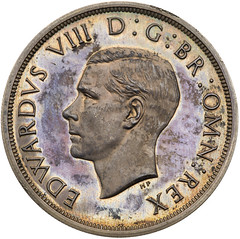
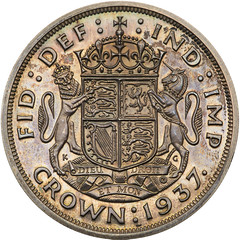
The reign of Edward VIII who famously abdicated his throne for the American divorcee he loved, Wallis Warfield Simpson, did not produce any portrait coinage for circulation. The plans and proposals had been long in gestation as the King insisted on facing left like his Father rather than adhering to the centuries old tradition of facing the opposite direction to the predecessor. The coinage was about to reach fruition when the King abdicated on the 10th December 1936 and all that was produced were six proof sets of his proposed coinage.
Four complete sets are institutionalised today in the Royal Collection, British Museum and two in the Royal Mint. One complete set is in the private hands of the Tyrant Collection arguably the most valuable coin collection ever formed. The sixth set is the only one to have been separated and the component coins are the only examples of his portrait British coins available individually. Therefore, this represents an unrivalled opportunity as it did once for Mr Smith in the year 2000 to bid for and perhaps end up owning the largest silver portrait coin of the King who became the Duke of Windsor.
Looking at the collection chronologically, every one of the 57 coins has an interesting story to tell whether from point of view of the history of the monarch behind the issue, the circumstances or method in which they were struck, the amazing quality of the surviving coin, the history of the previous ownership, or perhaps more than one of these factors coupled together.
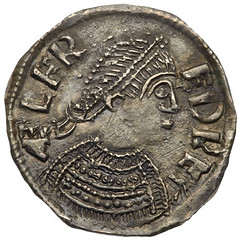
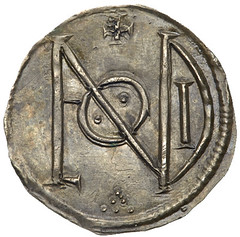
The collection starts with an amazing portrait silver Penny of King Alfred the Great (871-899) with his diademed portrait facing right, ALFRED REX in bold characters around and the "Londinia" Monogram on the reverse side, one of the most desirable designs of his coinage. The collection progresses onward with a series of impressive portrait pennies of the Anglo-Saxons into the Normans and Medieval period until the reign of King Edward I.

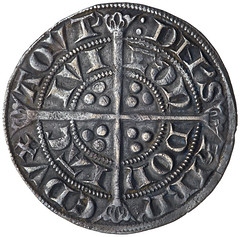
One of the most spectacular designs of the English Medieval Series is the large silver Groat of Fourpence first issued during the reign of King Edward I (1272-1307) when a major new coinage initiative was introduced in 1279. Issued for a number of years in this reign, the denomination was not issued by his successor and only had a more successful launch during the reign of Edward III. An endearing design the surviving Edward I portrait Groats usually found use later as brooches or badges and were often gilt. The example in the Smith Collection does not seem to have suffered from any such rigours and is consequently perhaps the best example available to private collectors.

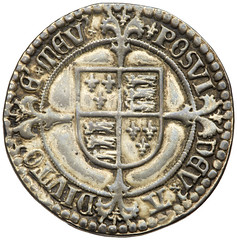
A true life-like profile portrait, the brand-new largest denomination toward the end of the reign of King Henry VII was that of the Testoon of One Shilling face value at Twelve Pence. Issued in the Renaissance period the artistic style in which the portrait was rendered by a master engraver thought to be Alexander de Brugsal, the example herewith is of the earliest type without a numeral after the King's name. Always a highly coveted piece issued at the dawn of true-life numismatic portraits under the Tudors, today such coins are rarely offered for sale giving an unrivalled opportunity to bidders.
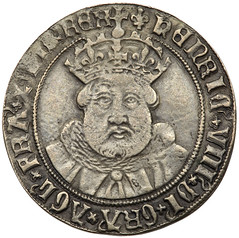

A wonderful depiction of Tudor King Henry VIII in the twilight of his years appears in the typical "Holbein" style upon the silver Testoon of his final coinage, the largest and most impressive coin portrait of Henry. As the issue progressed the King was secretly debasing the coinage, though this example is one of the earlier issued in better silver with his Kingly number given in Roman numerals after his name. The full bloom Tudor rose on the reverse is perfectly rendered in the striking and the coin has a provenance of ownership that stretches back to the first half of the 19th Century with the famed collectors of the past such as Pomfret, Gibbs, Richardson, Murdoch and Hilton-Price having once owned this coin.
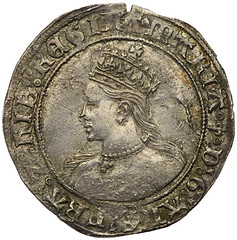

As the largest numismatic bust portrait of Mary Tudor exists in the Irish coinage upon her Shilling the Neil Smith Collection diversifies here to possess an example of the Queen coupled with the Irish harp on the reverse. Dated in Roman numerals in the legend the coin is perhaps one of the best examples that can be found of this rare coinage and has a provenance stretching back over 60 years.
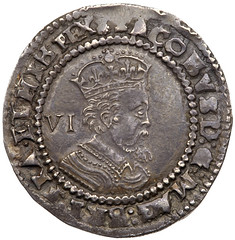

The Neil Smith Collection diversifies again in the reign of James I as the larger portrait upon the shilling is not represented for once. This is because a superb smaller portrait upon the extremely rare heavy weight Sixpence, was available to Mr Smith from the famed Shuttlewood Collection nearly twenty years ago. Only four such "piedfort" Sixpences are in private ownership and this one is dated 1623 and is the best quality survivor of the four pieces. Reasons for striking such thicker flan pieces are not known but it can perhaps be assumed such a piece was ear marked for special presentation.

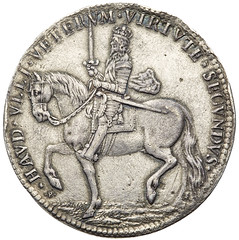
This enigmatic Pattern silver coin, undated, designed and engraved by Nicholas Briot as his distinct style and character set of lettering show, the coin is the same diameter as but not as heavy as the crown. Perhaps a presentation piece to show two different designs for the obverse of a crown, the coin is full of artistic merit and one of only a handful known. The provenance is impeccable stretching back nearly 200 years and once owned by such numismatic luminaries as Higgs, Cuff, Wigan, Young, Bieber, Murdoch, Wakley, Clarke, Lingford, Thorpe and Brooker.
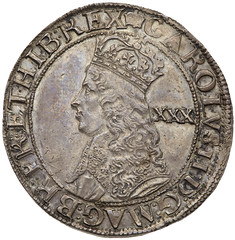
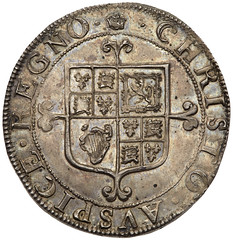
Of the highest quality, this well struck example of the largest silver hammered portrait of King Charles II dates from the final issue before the change-over to machine made milled coins. Examples of coins from this issue are often seen but they are always poorly struck with weakness and imperfections. To find an example of this issue of the calibre of this piece is truly the exception and has obviously been carefully prepared and struck so well-centred and with such an even strike. With a provenance of previous ownership stretching back over 100 years and having been a front cover coin on a past auction catalogue the quality speaks for itself.
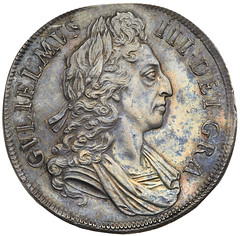
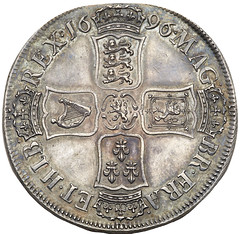
The last time we can trace one of these extremely rare presentation proof crowns for sale of King William III by public auction was when this very coin was last offered as part of the Van-Roekel Collection of Crowns in 2001. There are elements to the design of the reverse which are only seen on the proof version of the crown and is struck with a plain edge.
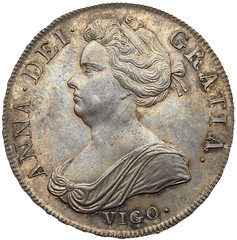
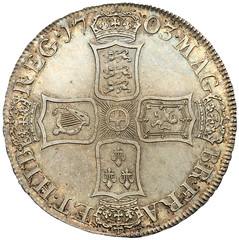
Superb examples of the largest silver Vigo coin are few and far between, and the demand for quality when coupled with the fact this coin is struck from the silver captured at Vigo Bay on 23rd October of 1702 will no doubt attract bidders from around the world.

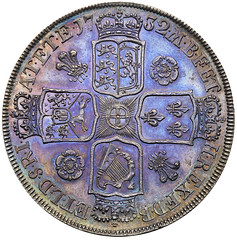
With iridescent rainbow colouring this silver Proof Crown, the first and rarest of the reign of Hanoverian King George II dated 1732, is a superb example of the ilk with the Kings young head portrait and the roses and plumes to signify the coin is struck from a mixture of English and Welsh derived silver.
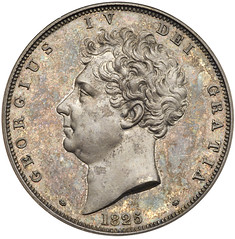
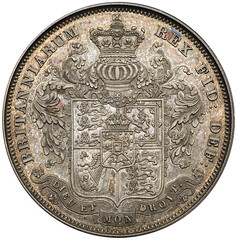
This silver Proof Crown dated 1825 is the pattern issued the year before the 1826 version that formed part of the proof set of coins and is subsequently much rarer. A beautiful portrait piece from the skilled hand of William Wyon, later a fellow of the Royal Academy of Art, the background toning on the fields of the coin only enhances the detail and boldness of the design and lettering.

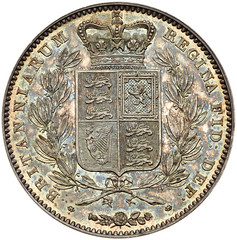
Produced exclusively for the first complete proof set of the Young Head coinage of Queen Victoria, the 1839 silver Proof Crown is the largest numismatic depiction of the Queen by William Wyon, whose name appears on the truncation of the neck, with the letters R.A. after signifying his fellowship of the Royal Academy of Arts. The background toning on the fields of the coin only enhances the portrait, shield reverse and lettering. Only circa 300 sets of coins were produced and sold at the time which would contain such a coin.
For more information on the sale, see:
http://dev.thenewyorksale.com/current-auction/
For more information on Sovereign Rarities Ltd, see:
https://www.sovr.co.uk/

CHRISTIAN GOBRECHT'S 1826 ARCHIMEDES MEDAL
Len Augsburger published this article on the 1826 Archimedes medal by Christian Gobrecht in the December 2019 issue of The E-Gobrecht, an electronic publication of the Liberty Seated Collectors Club. With permission, we're republishing it here. Thanks. -Editor
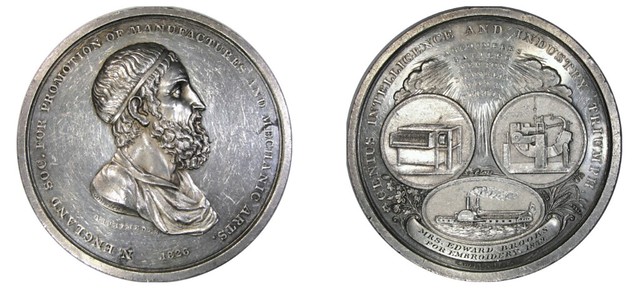
A Gobrecht Medal Finds a Good Home At the ANA convention I got to talking with Neil Mu- sante of the Medal Collectors Association about the 1826 Archimedes medal (Julian AM-55) engraved by Christian Gobrecht for the New England Society for Promotion of Manufactures and Mechanic Arts. Neil thought it was quite rare and wished to add an example to his collection. Seeing as I had two of them, and that it would be going to a "good home," I did the deal and the piece illustrated was sold. Later I realized that previous appearances of this medal could be located rather easily using Newman Portal, and a brief search yielded some results. First off, how many were struck? Bob Wester, writing in the NENA News (1986, no. 2) reported that 15 were awarded in 1826 and 20 in 1828. His source is unnoted but is probably the Society proceedings or minutes. After that we look at the medals themselves. Typically the awardee's name was engraved by hand in the lower reverse, but a few of these are blank, suggesting that they were una- warded remainders or that the recipient never had their name engraved in this space. The following awarded examples are known:
Thomas Hurd
Mrs. Edward Brooks
Samuel F. Coolidge
Francis Peabody
Benjamin Loring
Christian Gobrecht
Of the last, special mention is required. Gobrecht's grandson, who would have known, wrote in the early 20th century that the first presentation of this award was made to Gobrecht himself, in acknowledgement of the artistry demonstrated in the execution of the dies. The whereabouts of this medal is unknown, and apart from this single mention over a hundred years ago, there is no further information. It may still reside in the family. Needless to say, the appearance of this medal would draw substantial commercial interest. There is also the possibility that Gobrecht's example was never engraved with his name, meaning that we would never be able to tell which of the blank pieces might have been his.
Further searching revealed 19 auction appearance between 1867 and 2005, meaning that an example appears at auction about once every seven years. A few fixed price listings were also found, most notably a pleasing toned (unawarded) piece recently sold by John Kraljevich. Finally, examples were located in the American Numismatic Society and the Massachusetts Historical Society, both unawarded. Beyond the six named pieces listed above, there are perhaps another half dozen unawarded pieces out there, suggesting a population of 12 silver pieces.
In addition, there are a few related oddball items. Woodward's sale of the Mickley collection 1867) offered plaster impressions of both the obverse and reverse dies. These have not reappeared on the market. The Presidential Coin and Antique sale of 1/16/1987 presented a white metal example, said to be on a cast planchet. This was likely a test impression prior to striking the silver pieces. Finally, the Gobrecht catalog prepared by his grandson, c. 1900, mentioned a copper example in the stock of S.H. and H. Chapman, Philadelphia dealers. The copper piece has not been mentioned since, and is likely worth more than most of the silver examples.
For more information on the Liberty Seated Collectors Club, see:
http://www.lsccweb.org/

1826 GOLD ERIE CANAL COMPLETION MEDAL
A Stack's Bowers blog article by Senior Numismatist Ben Orooji highlights a very rare gold example of the classic Erie Canal Completion medal. -Editor
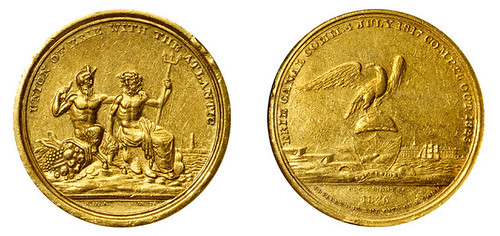
Though our March Baltimore 2020 Auction is three months away, consignments have been rolling in for this popular and exciting event. One of the highlights received thus far is an exceptionally rare so-called dollar, the famous Erie Canal Completion medal struck in gold.
There are only three known examples of this phenomenal rarity, two of which are in private hands. The medal was struck to commemorate the completion of the Erie Canal in 1825, an engineering feat that ushered in an era of economic, cultural and political prosperity in New York, specifically New York City, whose increasing importance as a port city outpaced competing ports along the Eastern Seaboard. The Canal was directly responsible for bringing the agricultural products of the western interior to markets in the East, and bringing finished goods from the port of New York City to the interior, all the while slashing the cost of transportation by 95% from the usual overland routes.
To commemorate the Canal's completion, the Common Council of New York City authorized a medal and put its execution in the able hands of Archibald Robertson, a contemporary American artist. Robertson designed the medal. Iron and steel worker William Williams made the dies upon which famed medalist Charles Cushing Wright engraved the designs and Richard Trested punched the legends. The medals themselves were struck by Maltby Pelletreau of Pelletreau, Bennett and Cooke, Pelletreau being from a family of New York silversmiths dating back to colonial times.
The medals were struck in white metal, silver and gold. White metal impressions were presented to invited guests of the Corporation of New York, while silver impressions were given to select dignitaries and government officials. Gold specimens were reserved for persons of the highest order including the surviving signers of the Declaration of Independence, the family of George Washington, the current and past (living) Presidents, Marquis de Lafayette, and other very select individuals. A total of twelve gold examples were distributed to named persons, based on contemporary newspaper accounts. Today, we know of three that have survived.
The piece to be presented in our March Baltimore auction is certified by NGC as EF-45 and features Pan and Neptune on the obverse with a distant view of the ocean and a lighthouse. The reverse shows the New York coat of arms with a representation of the canal and the city of New York. The surfaces are medium gold and retain a satin to modestly semi-prooflike finish. The detail is sharp throughout the obverse, and bold on the reverse apart from a touch of softness to the high points. The provenance is largely unknown apart from it coming out of a European estate.
President John Quincy Adams' example, certified by NGC as Proof-62, last sold at auction in 2014. President Andrew Jackson's example described as "Extremely Fine" was donated to the New York Historical Society in 1832. This example could very well be Washington's, Lafayette's, James Madison's or perhaps one of the signers of the Declaration of Independence. Speculation? Of course, but it doesn't hurt to imagine. Definitively concluding to whom this piece was originally presented is probably impossible, but in time, perhaps clues will surface that will give additional direction. In any case, this is a historic and exceedingly rare medal commemorating one of the most important engineering achievements of the early United States. We anticipate strong bids and heavy competition.
The medal's original owner may never be known, but it's clearly someone quite notable at the time. Great medal commemorating a great engineering achievement. -Editor
To read the complete article, see:
Exceedingly Rare Gold 1826 Erie Canal So-Called Dollar to be offered in our March 2020
Baltimore Auction (https://www.stacksbowers.com/News/Pages/Blogs.aspx?ArticleID=erie-canal-gold-medal)
THE BOOK BAZARRE
CONFEDERATE $20 NOTE HELD BY LEE AT APPOMATTOX
A Stack's Bowers blog article by Currency Specialist Brad Ciociola highlights a common note with an uncommon provenance. -Editor
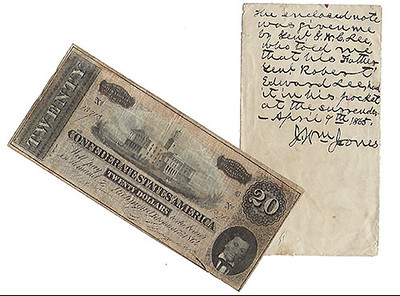 A Confederate T-67 $20
bill that was held by General Robert E. Lee during his surrender at Appomattox Court House, Virginia on April 9, 1865 will be offered in Stack's Bowers Galleries' March
2020 Official Currency Auction of the Whitman Coin & Collectibles Spring Expo.
A Confederate T-67 $20
bill that was held by General Robert E. Lee during his surrender at Appomattox Court House, Virginia on April 9, 1865 will be offered in Stack's Bowers Galleries' March
2020 Official Currency Auction of the Whitman Coin & Collectibles Spring Expo.
On the afternoon of April 9, 1865 Confederate General Robert E. Lee met with Union General Ulysses S. Grant under a flag of truce to discuss the terms of Confederate surrender. The two military leaders reached an agreement at the home of Wilmer McLean.
The note has an impeccable pedigree from Lee family friend Reverend J. William Jones and is accompanied by a note on an envelope from Jones that reads:
"The enclosed note was given me by Gen. G.(eorge) W.(ashington) C.(ustis) Lee, who told me that his father, Gen. Robert Edward Lee, had it in his pocket at the surrender – April 9th 1865. J. Wm. Jones."
Jones was a Southern Baptist preacher who served as a Confederate chaplain during the Civil War. Later he became a campus minister at Washington College where he met Robert E. Lee. He eventually served as campus minister at both the University of Virginia and the University of North Carolina at Chapel Hill.
Jones was picked to edit General Lee's papers and was given approval to publish Personal Reminiscences, Anecdotes and Letters of General Robert E. Lee in 1874. He published another Lee biography in 1906. Each has been reprinted dozens of times.
It is reasonable to surmise that Lee's eldest son gifted Jones the note as a gesture of appreciation for his work on the general's biography.
The relic itself is a mid-grade 1864 $20, a fairly common note as a type. However, its presence as a witness to one of the most significant events in American history makes it a highly desirable collectible that will appeal to both historical collectors and numismatists alike.
To read the complete article, see:
Confederate $20 Held by Lee at Appomattox Surrender to be Featured in March Baltimore
Currency Auction (https://www.stacksbowers.com/News/Pages/Blogs.aspx?ArticleID=lees-confederate-note)

LOOSE CHANGE: DECEMBER 8, 2019
Here are some additional items in the media this week that may be of interest. -Editor
1643 Deed Acquired By Brooklyn Historical Society
This non-numismatic article from Art Daily describes an artifact all collectors could appreciate - a New York property deed from 1643 highlighting a colorful early resident, Anthony the Turk. Worth reading in its entirety - see the complete article online. -Editor
 It arrived at the Brooklyn
Historical Society's stately headquarters in Brooklyn Heights in an unassuming brown package, fresh from Christie's, where the historical society bought it in October for
$27,500. Upstairs in the library, a small group gathered as Maggie Schreiner, the manager of archives and special collections, placed the package on a low shelf used to store
fire-insurance atlases and gently sliced it open.
It arrived at the Brooklyn
Historical Society's stately headquarters in Brooklyn Heights in an unassuming brown package, fresh from Christie's, where the historical society bought it in October for
$27,500. Upstairs in the library, a small group gathered as Maggie Schreiner, the manager of archives and special collections, placed the package on a low shelf used to store
fire-insurance atlases and gently sliced it open.
"There it is!" Deborah Schwartz, the historical society's president, said in an awed whisper, as the document — deeply creased from repeated folding, its ink slightly faded to brown — came into view. "Wow."
The deed, which will be on view at the historical society from Dec. 11-15, is "far and away" the most important item it has acquired recently, Schwartz said. It's also one that arrived at a fortuitous moment.
When the auction listing popped up, the historical society had just completed a three-year oral history project and exhibition documenting Muslims in Brooklyn — a community that has deep roots in the borough but was all but invisible in the society's archives.
The story of Anthony van Salee, who was born in 1607, certainly provides plenty to think about. His father, Jan Jansen, a Dutch privateer, was captured by one of the Moorish states in 1618. He reportedly converted to Islam, possibly by force, and became one of the famed Barbary pirates. (Van Salee was a reference to the Moroccan port of Salee, where the family lived for a time; "Turk," as in "Anthony the Turk," was a derogatory term used at the time for Muslims of any ethnicity.)
Anthony set sail for New Amsterdam in 1629 and before long acquired a large farm just north of the city stockade at Wall Street, along with a reputation as one of the most quarrelsome characters in a town full of them.
To read the complete article, see:
For a colorful Brooklyn real-estate pioneer, a
376-year-old receipt (https://artdaily.cc/news/119000/For-a-colorful-Brooklyn-real-estate-pioneer--a-376-year-old-receipt#.XevEsOhKhPY)
Creating the Peace Dollar
Mike Garofalo penned a nice article on the Peace Dollar for the Greysheet. -Editor
 De Francisci's original
obverse design portrayed a more normal-looking Miss Liberty as opposed to a more allegorical representation of her. The approved design removed the stops before and after the date
and changed the date from Roman to Arabic numerals.
De Francisci's original
obverse design portrayed a more normal-looking Miss Liberty as opposed to a more allegorical representation of her. The approved design removed the stops before and after the date
and changed the date from Roman to Arabic numerals.
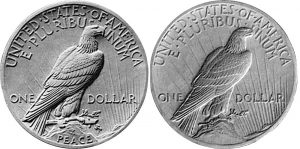
The approved reverse design [left] and de Francisci's original design [right].
To read the complete article, see:
Peace Dollars—The "Other" Silver Dollars
(http://blog.greysheet.com/peace-dollars-the-other-silver-dollars/)
Ancient Gold Coin Dropped in Salvation Army Kettle
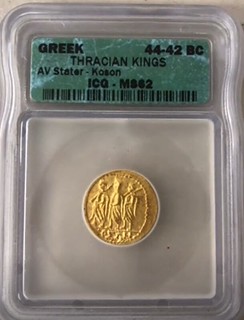 Every holiday season we read
reports of "rare" coins being dropped in Salvation Army kettles by anonymous donors. Usually these "coins" are just bullion pieces, not rare at all, just
valuable for their metal content. But here's a report from Tampa, FL of the donation of a gold Thracian Kings Greek coin from 44-42 BC, said to be worth about $2,000. Found
via The Explorator newsletter. -Editor
Every holiday season we read
reports of "rare" coins being dropped in Salvation Army kettles by anonymous donors. Usually these "coins" are just bullion pieces, not rare at all, just
valuable for their metal content. But here's a report from Tampa, FL of the donation of a gold Thracian Kings Greek coin from 44-42 BC, said to be worth about $2,000. Found
via The Explorator newsletter. -Editor
"This small coin has the power to make a huge difference in the lives of the people we serve," said Captain Andy Miller, the Area Commander of the Salvation Army of Tampa.
To read the complete article, see:
Anonymous
donor drops rare $2,000 gold coin into Salvation Army Kettle
(https://www.wtsp.com/article/news/local/anonymous-donor-drops-rare-gold-coin-valued-at-2000-into-salvation-army-kettle/67-20aadb71-4439-4389-bf15-014dba9295e0)

FEATURED WEB SITE: NEW YORK TOLL SCRIP & TOKENS
This week's Featured Web Site is suggested by George Cuhaj: Philip M. Goldstein's Toll scrip & tokens from the bridges & tunnels in the New York metropolitan area.
From the site's Introduction:
As with most obscure ephemera & exonumia issues, in-depth details regarding the toll scrip and token issues of the New York Metropolitan area were severely lacking.
While collectors including myself for years have known of and acquired these token & scrip issues; short of club or convention presentations, not much was publicity known nor has documentation has been forthcoming to recording their history to posterity. To this collectors best knowledge and research, this is the first online website regarding these issues, and it was borne out of research.
And while I do collect them, this website strictly covers the bridges and tunnels and will not cover token and script issues for the turnpikes, parkways and thruways. Not yet, anyway.
For those token issues that are known, I use the widely recognized and respectable Atwood Coffee Catalog for United States & Canadian Transportation Tokens, Seventh Edition (2016), Volume One.
However; the impetus for this website is, as I compiled this information and composed this website, I have encountered token varieties that are not listed. So, I took the liberty to expand upon the Atwood Coffee numbering system with a subletter.

www.nyctollscrip.info

